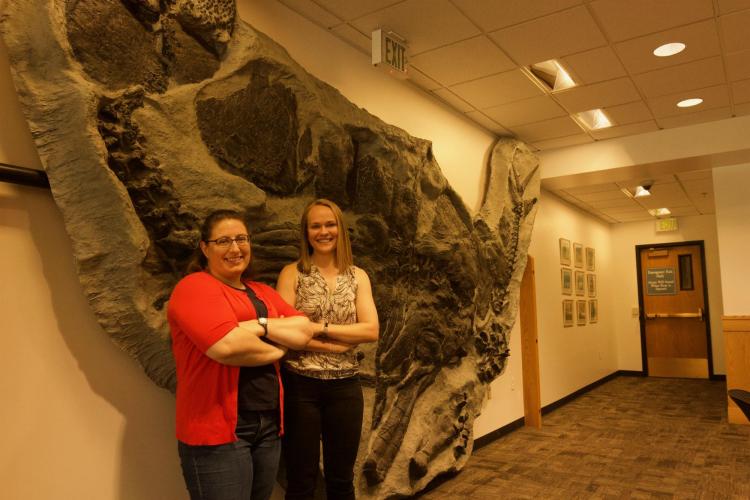Instructors improve the accessibility of geology
CU Boulder geologists are addressing one of their field’s big struggles, accommodating people with physical limitations
Emily Fairfax fainted when she started her PhD in geology at the University of Colorado Boulder in 2015.
She was out in the field near Boulder, and it was a hot day. “We were standing and walking to another stop, standing and walking to another stop,” she said.

Megan Brown and Emily Fairfax stand in front of a Stegosaurus skeleton in CU Boulder’s Jerry Crail Johnson Earth Sciences & Map Library. Photo by Lucas Joel. At the top of the page, reserchers on Vesuvio Crater in Italy check instruments and a solar panel to take data for geological science. iStockphoto.
Then she zonked out.
It was Fairfax’s first brush with geology, and it was after she fainted that she had the realization, in conversation with her then-fellow graduate student, Megan Brown, that geology has a problem:
It can be adventurous, like a series of posters in a travel agency that advertise exotic getaways—Trek the depths of an active volcano, Hike the Himalayas—and it can also be inaccessible for those for whom going to such places is, for whatever reason, impossible. The thought that they must be able to take these journeys to study geology can stop a budding career in its tracks.
And, for that reason, the geosciences have the lowest enrollment among the physical sciences of students with physical disabilities, one researcher reported
“How does one change culture?” asked Fairfax, who is now an assistant professor at California State University Channel Islands—particularly when the outdoors form the bedrock of geology’s culture.
Her answer and Brown’s: By changing it where students first meet that culture, in the classroom with a teacher. According to Fairfax and Brown, who detailed their field’s accessibility problem in May in the Journal of Geoscience Education, instructors like teaching assistants and professors do not get the training they need to showcase geology as the kind of field that takes all kinds.
We all lose out when we have a prescribed norm for what a geologist looks like or does.”
Geology, though, is not just about daring fieldwork. Brown, now an assistant professor at Northern Illinois University, studies hydrogeology, and she spends much of her time creating models on a computer. Students interested in the geosciences, she thinks, need to understand that there are valuable contributions that a geologist can make without ever donning hiking books or holstering a rock hammer on their belt.
Students who can’t trek into a volcano are not anomalies; they are an asset waiting to study the volcano or mountain from a different vantage, according to Brown.
And instructors, she and Fairfax explained, need to introduce this view of geology before students learn to view it in a less inclusive way, which is why the duo advocate for designing curricula and teaching classes in a way that shines a light on all students and their diversity of abilities.
The two trained instructors using scenarios stemming from actual experiences, like when Fairfax taught a geology class where students needed to get outside and go to Boulder Creek, where they needed to wade into the water to take measurements.
One student, she found, had a fear: getting into the running water. It was Fairfax’s fainting moment, but in a different guise, and she didn’t have a plan. (Must be able to wade into rushing water, the travel poster read.)
The main thing, said Fairfax, is for instructors to ask themselves what in this class might be inaccessible and, if anything inaccessible arises, then, “TAs need to have a contingency plan.” For the creek scenario, an adjustment could be to create a new part of the assignment that involves collecting data from the shore, and that new part of the assignment must be an option for all students—not just those who can’t go in the creek.
After they trained accessibility to the instructors in CU Boulder’s Department of Geological Sciences, Fairfax and Brown surveyed students and found that the number of students approaching instructors about accessibility needs increased compared to previous years. This could be a sign that those students will be less tempted to drift away from the field.
“We all lose out when we have a prescribed norm for what a geologist looks like or does,” said Brown. After all, it took someone fainting—not someone summiting some high peak—for a field to reexamine itself, and to evolve.

